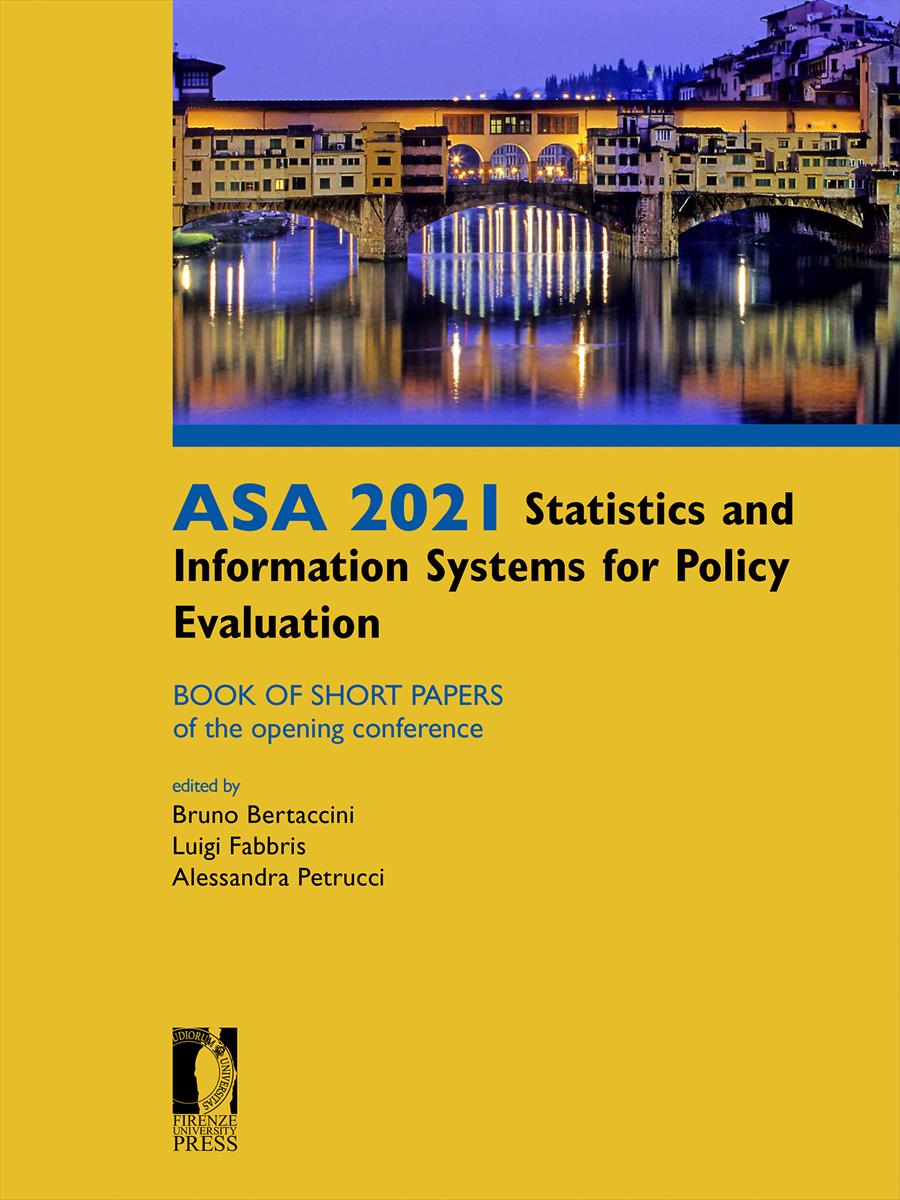- ASA 2021 Statistics and Information Systems for Policy Evaluation
- Edited by Bruno Bertaccini, Luigi Fabbris, Alessandra Petrucci
Profiling visitors of a national park in Italy through unsupervised classification of mixed data
- Giulia Caruso
- Adelia Evangelista
- Stefano Antonio Gattone
- © 2021 Author(s) |
- CC BY 4.0
- DOI: 10.36253/978-88-5518-304-8.27
Cluster analysis has for long been an effective tool for analysing data. Thus, several disciplines, such as marketing, psychology and computer sciences, just to mention a few, did take advantage from its contribution over time. Traditionally, this kind of algorithm concentrates only on numerical or categorical data at a time. In this work, instead, we analyse a dataset composed of mixed data, namely both numerical than categorical ones. More precisely, we focus on profiling visitors of the National Park of Majella in the Abruzzo region of Italy, which observations are characterized by variables such as gender, age, profession, expectations and satisfaction rate on park services. Applying a standard clustering procedure would be wholly inappropriate in this case. Therefore, we hereby propose an unsupervised classification of mixed data, a specific procedure capable of processing both numerical than categorical variables simultaneously, releasing truly precious information. In conclusion, our application therefore emphasizes how cluster analysis for mixed data can lead to discover particularly informative patterns, allowing to lay the groundwork for an accurate customers profiling, starting point for a detailed marketing analysis.
- Keywords:
- Cluster analysis,
- mixed data,
- unsupervised learning,
- customers profiling,
University of Chieti-Pescara G. D'Annunzio, Italy - ORCID: 0000-0003-0236-6201
University of Chieti-Pescara G. D'Annunzio, Italy - ORCID: 0000-0002-7596-9719
University of Chieti-Pescara G. D'Annunzio, Italy - ORCID: 0000-0002-6143-9012
- Basak, J., De, R., Pal, S. (1998). Unsupervised feature selection using a neuro-fuzzy approach, Pattern Recognition Letters, 19 (11), pp. 997-1006.
- Bloom, J. Z. (2004). Tourist market segmentation with linear and non-linear techniques. Tourism Management, 25, pp. 723–733.
- Bui, H. T., Le, T. A. (2016). Tourist satisfaction and destination image of Vietnam's Ha Long Bay. Asia Pacific Journal of Tourism Research, 21(7), pp. 795-810.
- Caruso, G., Gattone, S.A., Balzanella, A., Di Battista, T. (2019). Cluster analysis: an application to a real mixed-type data set, in Models and Theories in Social Systems. Studies in Systems, Decision and Control, eds. C. Flaut, S. Hoskova-Mayerov´a and D. Flaut, vol. 179, Springer, Heidelberg, pp. 525– 533.
- Caruso, G., Gattone, S.A., Fortuna, F., Di Battista, T. (2018). Cluster analysis as a decision-making tool: a methodological review, in Decision Economics: In the Tradition of Herbert A. Simon’s Heritage. Advances in Intelligent Systems and Computing, eds. E. Bucciarelli, S. Chen, J.M. Corchado, vol. 618, Springer, Heidelberg, pp. 48–55.
- Cheung, Y., Jia, H. (2013). Categorical and numerical attribute data clustering based on a unified similarity metric without knowing cluster number, Pattern Recognition, 46 (8), pp. 2228-2238.
- Diday, E., Govaert, G. (1997). Classification automatique avec distances adaptatives. R.A.I.R.O. Informatique Computer Science, 11 (4), pp. 329–349.
- Foss A., Markatou, M., Ray, B., Heching, A. (2016). A semiparametric method for clustering mixed data, Machine Learning, 105, pp. 419-458.
- Hsu, C. H., Kang, S. K. (2003). Profiling asian and western family independent travelers (FITS): An exploratory study. Asia Pacific Journal of Tourism Research, 8 (1), pp. 58-71.
- Huang, Z. (1997). Clustering large data sets with mixed numeric and categorical values, in: Proceedings in the First Pacific-Asia Conference on Knowledge Discovery and Data Mining, Singapore: World Scientific, pp. 21–34.
- Ichino, M., Yaguchi, H. (1994). Generalized minkowski metrics for mixed feature type data analysis, IEEE Transactions on Systems, Man and Cybernetics, 305 (24), pp. 698-708.
- Lee, C. K., Lee, T. H. (2001). World culture EXPO segment characteristics. Annals of Tourism Research, 28(3), pp. 812–816.
- Nitanan Koshy, M. et al. (2019). Profiling the segments of visitors in adventure tourism: comparison between visitors by recreational sites. International Journal of Business and Society, 20 (3), pp. 1076-1095.
- Suleiman, J. S., & Mohamed, B. (2011). Profiling visitors to Palestine: the case of Bethlehem city. The Journal of Tourism and Peace Research, 1 (2), pp. 41-52.
- Thompson, K., Schofield, P. (2009). Segmenting and profiling visitors to the Ulaanbaatar Naadam festival by motivation. Event Management, 13, pp. 1-15.
- Yeung, D., Wang, X. (2002). Improving performance of similarity-based clustering by feature weight learning, IEEE Transactions on Pattern Analysis and Machine Intelligence, 24 (4), pp. 556-561.
Chapter Information
Chapter Title
Profiling visitors of a national park in Italy through unsupervised classification of mixed data
Authors
Giulia Caruso, Adelia Evangelista, Stefano Antonio Gattone
Language
English
DOI
10.36253/978-88-5518-304-8.27
Peer Reviewed
Publication Year
2021
Copyright Information
© 2021 Author(s)
Content License
Metadata License
Bibliographic Information
Book Title
ASA 2021 Statistics and Information Systems for Policy Evaluation
Book Subtitle
Book of short papers of the opening conference
Editors
Bruno Bertaccini, Luigi Fabbris, Alessandra Petrucci
Peer Reviewed
Publication Year
2021
Copyright Information
© 2021 Author(s)
Content License
Metadata License
Publisher Name
Firenze University Press
DOI
10.36253/978-88-5518-304-8
eISBN (pdf)
978-88-5518-304-8
eISBN (xml)
978-88-5518-305-5
Series Title
Proceedings e report
Series ISSN
2704-601X
Series E-ISSN
2704-5846
